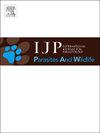欧洲野生爬行动物中的微生物:在被忽视的条件下弥合差距,为疾病生态学研究提供信息
IF 2.2
3区 医学
Q3 ECOLOGY
International Journal for Parasitology-Parasites and Wildlife
Pub Date : 2025-07-05
DOI:10.1016/j.ijppaw.2025.101113
引用次数: 0
摘要
在欧洲,尽管受到人类活动和环境变化的显著影响,爬行动物仍然是保护行动最少的脊椎动物之一。病原微生物对这些动物构成了另一项尚未得到充分调查的威胁,这主要是由于兽医的兴趣有限,传统上优先考虑圈养物种而不是野生种群。因此,对影响欧洲野生爬行动物的病原体的全面研究仍然很少和零散,为保护策略或健康风险评估提供有限的指导。本综述综合了目前关于欧洲野生非海洋爬行动物中潜在致病微生物(即细菌、真菌、原生动物和病毒)的知识。我们分析了来自主要科学数据库的123项同行评议研究。结果表明,在过去二十年中,尽管地理和研究焦点偏差仍然存在,但出版物显着增加。南欧国家,特别是西班牙、意大利和葡萄牙,在研究领域占主导地位,而北欧和东欧则存在显著差距。蜥蜴是最常被研究的宿主,尤其是与顶复合体寄生虫的关系,其次是蛇和乌龟。在微生物中,原生动物(特别是顶端复合体,如血碱)是最常被记录的,而细菌、真菌和病毒较少被报道,但从保护和/或人畜共患的角度来看,它们很重要。在后者中,沙门氏菌、蛇霉属和虹膜菌科的成员等分类群相对较有代表性。分子诊断越来越多地取代了传统的显微镜,然而关键的工具,如基于培养的方法和血清学仍然没有得到充分利用,限制了微生物和疾病特征的某些方面。二部宿主-微生物网络分析揭示了特定宿主内特定微生物群落促进的专业化模块化结构,它们本身受潜在的共同进化动力学或不均匀采样努力的影响。这些发现强调了将爬行动物疾病生态学纳入野生动物保护和公共卫生框架的重要性,强调了迫切需要扩大监测,特别是在代表性不足的分类群和地区,以便在“同一个健康”方法下有效应对新出现的疾病威胁。本文章由计算机程序翻译,如有差异,请以英文原文为准。

Microorganisms in wild European reptiles: bridging gaps in neglected conditions to inform disease ecology research
In Europe, reptiles remain among the vertebrates least addressed by conservation actions, despite being significantly impacted by human activities and environmental changes. Pathogenic microorganisms represent an additional yet poorly investigated threat to these animals, largely due to limited veterinary interest, which traditionally prioritises captive species over wild populations. Consequently, comprehensive studies on the pathogens affecting European wild reptiles remain sparse and fragmented, providing limited guidance for conservation strategies or health risk assessments.
This review synthesises the current knowledge on potentially pathogenic microorganisms (namely bacteria, fungi, protozoa sensu lato and viruses) in wild, non-marine reptiles across Europe. We analysed 123 peer-reviewed studies from major scientific databases. Results indicate a marked increase in publications over the last two decades, although geographical and research focus biases persist. Southern European countries, notably Spain, Italy and Portugal, dominate the research landscape, while significant gaps exist in Northern and Eastern Europe. Lizards emerge as the most frequently studied hosts, especially in relation to apicomplexan parasites, followed by snakes and turtles. Among microorganisms, protozoa (particularly apicomplexans such as haemogregarines sensu lato) are the most frequently documented, whereas bacteria, fungi and viruses are less commonly reported, but significant from conservation and/or zoonotic perspectives. Within the latter, taxa such as Salmonella, Ophidiomyces and members of the Iridoviridae are relatively well represented. Molecular diagnostics have increasingly supplanted traditional microscopy, yet crucial tools such as culture-based methods and serology remain underutilised, limiting certain aspects of microorganism and disease characterisation.
Bipartite host-microorganism network analysis revealed a specialised, modular structure promoted by specific microbial communities within particular hosts, themselves influenced by potential co-evolutionary dynamics or uneven sampling efforts.
These findings underline the importance of integrating reptile disease ecology into wildlife conservation and public health frameworks, emphasising the urgent need to expand surveillance, particularly in underrepresented taxa and regions, to effectively address emerging disease threats under a One Health approach.
求助全文
通过发布文献求助,成功后即可免费获取论文全文。
去求助
来源期刊

International Journal for Parasitology-Parasites and Wildlife
Medicine-Infectious Diseases
CiteScore
3.80
自引率
5.60%
发文量
113
审稿时长
45 days
期刊介绍:
The International Journal for Parasitology: Parasites and Wildlife (IJP-PAW) publishes the results of original research on parasites of all wildlife, invertebrate and vertebrate. This includes free-ranging, wild populations, as well as captive wildlife, semi-domesticated species (e.g. reindeer) and farmed populations of recently domesticated or wild-captured species (e.g. cultured fishes). Articles on all aspects of wildlife parasitology are welcomed including taxonomy, biodiversity and distribution, ecology and epidemiology, population biology and host-parasite relationships. The impact of parasites on the health and conservation of wildlife is seen as an important area covered by the journal especially the potential role of environmental factors, for example climate. Also important to the journal is ''one health'' and the nature of interactions between wildlife, people and domestic animals, including disease emergence and zoonoses.
 求助内容:
求助内容: 应助结果提醒方式:
应助结果提醒方式:


